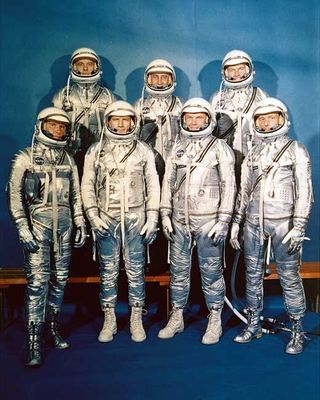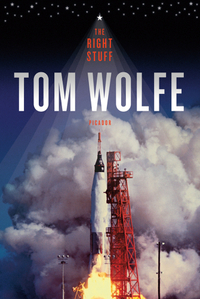These astronauts read Tom Wolfe's 'The Right Stuff' and flew in space. Here what it meant to them.
The new series "The Right Stuff" based on the book debuts on Disney Plus today.
Four-time space shuttle astronaut Steve Smith loved professional adventurers when he was a child. In the 1960s, Jacques Cousteau explored the ocean while astronauts were making their first journeys into space during NASA's Mercury program, which paved the way for the first astronauts to land on the moon in 1969.
It is this early world of spaceflight — and the test pilots who made up the first astronauts — that came to the fore in "The Right Stuff" — the 1979 book by Tom Wolfe, the 1983 Hollywood movie and the new National Geographic TV series that launches on Disney Plus today (Oct. 9) to cap World Space Week 2020.
In an interview with Space.com, Smith said that reading the book as a young man increased his commitment to space exploration "1000-fold," allowing him to persevere as initial rejections came in from NASA and the United States Air Force.
Related: 'The Right Stuff' lifts off on Disney Plus, takes flight from book, film
- Want to try Disney Plus? You can get a 7-day free trial here
- Sign up for Disney Plus for $6.99/month

The Right Stuff by Tom Wolfe | Save 43% on Amazon
Read the book that inspired a generation of engineers, scientists and astronauts and retells the early days of human spaceflight.
Smith recalled seeing Ed White perform the first American spacewalk in 1965, which spurred the 7-year-old's "singular goal" to fly in space one day. Other factors were exposing Smith to aerospace as well. A friend's father took him flying in a small airplane, and he spent significant time on commercial jets while his family was assigned to live in Japan for two years — requiring a lot of time going back and forth to the United States over the Pacific.
"But I knew nothing of behind the scenes. I knew no details about what the astronauts were like, nor what the path was to become one. 'The Right Stuff' changed everything for me. The book filled a huge void," said Smith, who spoke about his spaceflight experiences Tuesday (Oct. 6) as part of The Virtual Astronaut online series.
"The Right Stuff" book and movie duo was influential to a generation of engineers and scientists, including the astronauts of NASA. Some, like Smith, took the movie as inspiration for exploring space and for overcoming obstacles along the way.
Get the Space.com Newsletter
Breaking space news, the latest updates on rocket launches, skywatching events and more!
Related: How Tom Wolfe inspired a generation of astronauts

"I found the book compelling, extremely interesting, and oftentimes humorous, as I would mentally place myself in the flight suits of these men who were to become the first," Clayton Anderson, who flew twice in space as a NASA space shuttle astronaut and International Space Station crew member, told Space.com.
The movie scene that stuck out to him most, however, was a humorous rendition of the early medical procedures that the astronaut candidates went through to prepare them for spaceflight — procedures which have changed substantially since the 1960s.
"[My] takeaway was that if I was ever to become a real astronaut, I wanted no one to see my bare-naked rear end, fully exposed in the revealing flap of a single-tie hospital gown, as I sprinted down a hospital hallway in search of an 'enema-tic' release of supernova proportions. I guess that means I may not have really had 'the right stuff'," Anderson joked, presumably having never needed to undergo that scenario himself during his astronaut career a generation later.
"The Right Stuff" by Tom Wolfe | $12 on Amazon
Read the book that inspired the National Geographic/Disney Plus series about NASA's original Mercury Seven astronauts.
Two-time NASA space shuttle astronaut Danny Olivas, who will speak on The Virtual Astronaut series Oct. 14, recalled another portion of the medical testing in the movie.
"There is a section where the astronauts are being evaluated for their lung capacity by having them blow into a medical device. All the astronauts were competing with one another to see who could sustain their airflow longer. After virtually all of them exhaust themselves, they look over at John Glenn, who is quite easily continuing to exhale," he told Space.com.
"That segment encapsulates what I saw as the level of competition to become an astronaut, not just between their peers, but as individuals. It was that mindset that informed me. If I wanted to become an astronaut, I would have to be prepared to compete at a very high level, and push myself to my own limits. I still think about that scene to this day, and continue to push myself."
Related: What it's like to become a NASA astronaut: 10 surprising facts
But the medical scenes of the movie also underlie some of the controversy of "The Right Stuff" film, which some of the older astronauts said was not an accurate rendition of their training. "Tom Wolfe's coverage of it was pretty good. The movie was lousy, but Tom Wolfe's coverage in the book, I thought, wasn't bad at all," Glenn, who died in 2016, told NASA in a 1997 oral interview.
Fellow Mercury astronaut Scott Carpenter, another of the main characters of the book and the movie, told NASA in 1999 that he had "great affection" for Wolfe, but some troubles with the movie based upon his book.
"He is a bright, bright, fine man; and I think the film is a great film," said Carpenter, who died in 2013. "I'm asked about it frequently, and people say, 'Does it tell the truth?' And I say what I believe: that the book and the movie, for that matter, are truthful ... both of them take some literary license with facts, but only nonessential facts. The important details portrayed by both the book and the film are presented accurately."

The movie also provoked strong opinions from some of those who joined the NASA astronaut corps later in the 1960s, during the Gemini and Apollo programs. Those astronauts interacted directly with the real-life people featured in "The Right Stuff," allowing them to think critically about the story's accuracy.
"I haven't read the book critically. I'm not sure I've read it all," Gemini astronaut and Apollo 11 moonwalker Neil Armstrong, who died in 2012, told NASA in 2001. "I did see the movie. I thought it was very good filmmaking, but terrible history. The wrong people working on the wrong projects at the wrong times. It bears no resemblance whatever to what was actually going on."
NASA space shuttle astronaut Joe Allen was selected to join the astronaut corps in 1967 and became familiar with many of the personalities portrayed in the book, which he talked about in a NASA oral history in 2003. "These [people] are, in many ways ... personified by the description of Tom Wolfe in the book 'The Right Stuff'. He exaggerates it ... but he underscores a mindset of these people. They're a very extraordinary group, and they, no choice of their own, found themselves in an extremely high-profile job because of the wild enthusiasm in the eyes of the American public [for] this extraordinary undertaking and adventure."
Mindset was also what Gemini and Apollo astronaut Jim McDivitt focused on in his NASA interview in 1999. "If you've seen 'The Right Stuff', that [training approach] … really came out of the [U.S. Air Force] Test Pilot School," McDivitt said. "We taught each other. We just sort of divided up the things that we wanted to [and] thought we ought to learn, and then one of us would bone up on that and then we'd teach the other guys."

At least some astronauts, however, used "The Right Stuff" as cultural touchstones to discuss milestones in their training. Gerald Carr was selected by NASA in 1966 and flew during the Skylab 4 space station mission in 1973.
"Our [qualification] physical was very much like the one that they show in the movie 'The Right Stuff', just about all the same stuff," Carr said to NASA in 2000; he died earlier this year. "We didn't have any of the comedians like [astronaut] Pete Conrad in the movie, but there was lots of good memories about that. It's an unforgettable experience, I'll tell you."
John Blaha, a space shuttle astronaut of the 1980s, recalled a different facet of "The Right Stuff" after his STS-29 crew was invited to The White House in 1989 to meet then-President George H. W. Bush, during a presidential phone call to the space shuttle.
"Did you see that movie, 'The Right Stuff'?" Blaha said during his NASA interview in 2004. "You know that one area in there where one of the wives says something to the effect of, 'I can't wait until we go to the White House and see Jackie [First Lady Jacqueline Kennedy],' or something like that. Well, that was true of space flights. So now when [Bush] said that on-orbit, it was kind of like, 'Hey, we get to go to the White House and see George.' "
Blaha, who eventually took Bush up on the invitation, laughed at the memory. "That was a fun thing," he added.
Follow Elizabeth Howell on Twitter @howellspace. Follow us on Twitter @Spacedotcom and on Facebook.
Join our Space Forums to keep talking space on the latest missions, night sky and more! And if you have a news tip, correction or comment, let us know at: community@space.com.

Elizabeth Howell (she/her), Ph.D., is a staff writer in the spaceflight channel since 2022 covering diversity, education and gaming as well. She was contributing writer for Space.com for 10 years before joining full-time. Elizabeth's reporting includes multiple exclusives with the White House and Office of the Vice-President of the United States, an exclusive conversation with aspiring space tourist (and NSYNC bassist) Lance Bass, speaking several times with the International Space Station, witnessing five human spaceflight launches on two continents, flying parabolic, working inside a spacesuit, and participating in a simulated Mars mission. Her latest book, "Why Am I Taller?", is co-written with astronaut Dave Williams. Elizabeth holds a Ph.D. and M.Sc. in Space Studies from the University of North Dakota, a Bachelor of Journalism from Canada's Carleton University and a Bachelor of History from Canada's Athabasca University. Elizabeth is also a post-secondary instructor in communications and science at several institutions since 2015; her experience includes developing and teaching an astronomy course at Canada's Algonquin College (with Indigenous content as well) to more than 1,000 students since 2020. Elizabeth first got interested in space after watching the movie Apollo 13 in 1996, and still wants to be an astronaut someday. Mastodon: https://qoto.org/@howellspace

